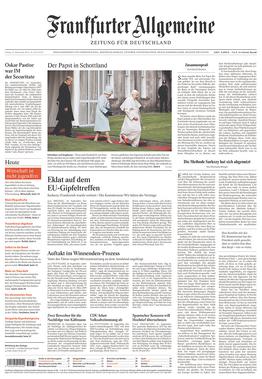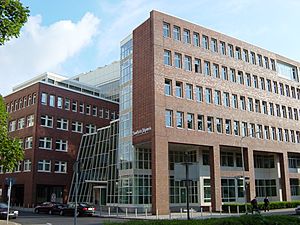Frankfurter Allgemeine Zeitung facts for kids
 |
|

The 17 September 2010 front page
|
|
| Type | Daily newspaper |
|---|---|
| Format | Nordisch |
| Owner(s) | Fazit-Stiftung |
| Publisher | Carsten Knop Berthold Kohler Jürgen Kaube Gerald Braunberger |
| Founded | 1 November 1949 |
| Political alignment | Liberal conservatism Conservative liberalism Centre-right Pro-CDU/CSU |
| Language | German |
| Headquarters | Frankfurt, Germany |
| Circulation | 201,408 (Print, 2021) 56,000 (Digital, 2020) |
| ISSN | 0174-4909 |
The Frankfurter Allgemeine Zeitung (often called FAZ) is a well-known German newspaper. It started in 1949 and is printed every day in Frankfurt, Germany. Many people see it as a very important newspaper for Germany. It also has a Sunday edition called the Frankfurter Allgemeine Sonntagszeitung (or FAS).
The FAZ has its own reporters all over the world. These reporters help gather news from different places. The newspaper's main ideas are decided by a team of four editors, not just one person.
Contents
The Story of FAZ
How the Newspaper Started

The very first FAZ newspaper came out on November 1, 1949. The people who helped start it were Hans Baumgarten, Erich Dombrowski, Karl Korn, Paul Sethe, and Erich Welter. Erich Welter was an editor until 1980. Some of these founders had worked for another newspaper called the Frankfurter Zeitung, which was stopped in 1943.
However, the FAZ editors made it clear that they were not just continuing the old newspaper. They said they admired the old paper but wanted to create something new.
For about a year, until September 30, 1950, the FAZ was printed in Mainz.
Changes in Look and Style
For a long time, the FAZ had a very traditional look. Many of its headlines used a special old-fashioned writing style called blackletter. Also, the front page usually did not have any photos.
There were a few rare times when photos did appear on the front page. For example, on October 4, 1990, there was a picture of people celebrating German Unity Day. On September 12, 2001, after the September 11 attacks, there were two pictures. These showed the World Trade Center falling and American president George W. Bush.
In the early 2000s, the FAZ tried to grow bigger. It added special sections for cities like Berlin and Munich. It even had an English-language edition that came out six days a week. This English version was put inside The International Herald Tribune. The articles were chosen and translated by the FAZ team.
However, the FAZ group lost a lot of money in 2002. By 2004, the special city sections were stopped. The English edition also became smaller, only coming out once a week.
On October 5, 2007, the FAZ changed its look again. It started using color photos on the front page. It also stopped using the old blackletter writing style for most of its text. This change was a big deal for many readers. It was even talked about in a comedy film in 2009.
Spelling Rules
In 1999, the FAZ started using new spelling rules for German. These rules were part of the German orthography reform of 1996. But exactly one year later, the paper went back to the old spelling. They said the new rules had not worked well.
After some more changes were made to the new spelling rules, the FAZ decided to accept them. Since January 1, 2007, the newspaper has been using a special version of the new spelling.
Important Articles
In December 1999, Angela Merkel, who later became the German Chancellor, wrote an article in the FAZ. She wrote about problems within her political party (CDU donations scandal). She blamed former Chancellor Helmut Kohl and said the party needed to change its direction.
What the FAZ Believes
The FAZ is known for its liberal-conservative views. This means it often supports ideas that are about freedom and tradition. However, it also allows writers with different opinions to share their thoughts.
In the German elections of 2013, the newspaper supported the CDU/CSU alliance.
Who Owns the FAZ
The FAZ company is a type of business called a GmbH (which means it has limited liability). Most of the company, about 93.7% of its shares, is owned by an independent group called the Fazit-Stiftung.
The Fazit-Stiftung was created in 1959. It is 'owned' by up to nine people. These people cannot sell their share. Instead, they pass it on to a new person who is chosen by the other owners. The rules of the foundation say that new members must be people who can make sure the FAZ stays independent. The current group of seven owners includes business leaders and lawyers.
The foundation also owns most of another company called 'Frankfurter Societät'. This company owns a printing business and a local newspaper called Frankfurter Neue Presse.
How Many Copies Are Printed
The FAZ is one of several important national newspapers in Germany. Others include Süddeutsche Zeitung, Die Welt, Die Zeit, Frankfurter Rundschau, and Die Tageszeitung. In 2011, the FAZ had 40 reporters working in other countries.
In 1993, the newspaper printed 391,013 copies. By 2001, it printed 409,000 copies. In 2007, about 382,499 copies were printed each day. By 2016, the daily number was 256,188 copies.
When the FAZ Was Blocked
Sometimes, the FAZ has faced bans in other countries.
- In 2006, the FAZ was banned in Egypt. This happened because it published articles that were seen as "insulting Islam."
- In February 2008, it was banned in Egypt again. This time, it was because of cartoons that showed Muhammad.
- In November 2012, the newspaper caused strong criticism in Spain. This was because of its views on Spanish people moving to Germany during a time of economic trouble.
- In July 2019, the FAZ website was blocked in China by the Great Firewall. Other German news websites were also blocked. The reasons were not clear, but the FAZ thought it might be because of its reports on the 2019–2020 Hong Kong protests.
People Who Write for FAZ
- Muhammad Asad
- Patrick Bahners
- Hans D. Barbier
- Eleonore Büning (music critic)
- Dietmar Dath
- Marc Degens
- Karl Feldmeier
- Joachim Fest (former editor)
- Friedrich Karl Fromme (former editor)
- Greser & Lenz
- Andrea Petkovic
- Georg Paul Hefty
- Florian Illies
- Daniel Kehlmann
- Barbara Klemm (photographer)
- Carsten Knop
- Christian Kracht
- Karl Lagerfeld (caricaturist)
- Ernst Nolte
- Andreas Platthaus
- Marcel Reich-Ranicki
- Volker Reiche (see Strizz)
- Johann Georg Reißmüller (former editor)
- Frank Schirrmacher
- Werner Spies
- Udo Ulfkotte (former editor)
See also
 In Spanish: Frankfurter Allgemeine Zeitung para niños
In Spanish: Frankfurter Allgemeine Zeitung para niños
- List of newspapers in Germany
- Media of Germany


